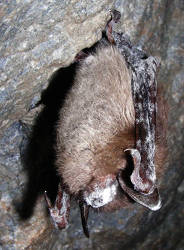White-nose Syndrome
Pseudogymnoascus destructans



The White-nose Syndrome (WNS) is a fungal infection in bats that is rampant in North America. It is caused by a fungus called Pseudogymnoascus destructans. This fungus is white and usually starts growing on the nose, which is how the disease got its name. On closer inspection it is not a disease at all, the bats are only overgrown by the fungus. Unfortunately, this happens during hibernation and leads to increased energy consumption in the animals. A large number of the animals therefore do not survive the winter.
Because WNS is not a disease there are no species boundaries for the fungus and most species of bats are affected. The fungus is present in the cave in the form of spores and infects practically the entire bat population over the winter. Once a cave is contaminated, it cannot be undone. The fungi are introduced by infected animals but also by human cave visitors and speleologists.
A well-founded assumption is that the fungus was originally introduced to North America by speleologists. It has also been found in many caves in Europe, but does not cause mass extinction there. Presumably European bats are in some way immune, as the fungus has been common here for some time. This of course raises the question of whether worldwide speleology will have to follow strict hygiene measures in the future to prevent the spread of animal diseases to other continents.
In the meantime the disease has spread throughout the western States of the U.S.A. and Canada. It has reached the midwest and there are also proven areas of spread on the west coast. The disease can neither be fought nor contained. Infected caves are closed and cave equipment is generally decontaminated in the hope that this will at least minimize the human acceleration of the spreading.
History
| FEB-2006 | discovered in the state of New York for the first time. |
| 2008 | Pseudogymnoascus destructans described for the first time. |
| 2009 | in several European countries (Germany, Austria, Hungary, France) clearly infected bats were found. |
| 2011 | Scientists have succeeded for the first time in directly identifying the fungus as the cause of the white-nose syndrome. |
| 19-MAY-2011 | United States Fish and Wildlife Service (USFWS) presents an action plan to stop the further spread of the white-nose syndrome. |
| 2011 | 5.7 million animals died. |
| 15-MAR-2012 | WNS Decontamination Team publishes national decontamination protocol. |
| 2018 | spread across 33 US States and 7 Canadian provinces. |
| 2019 | discovered in Bracken Cave, the world’s largest bat colony in Texas. |
Countermeasures
The most important measures obviously targer speleologists, they must inform themselves about the currently valid regulations if they want to go caving in the USA. The second group affected are the participants of Cave Trekking tours. However, just as with visitors to show caves and mines, the rules of the respective operators apply. This means that you will be provided with cave equipment that will only be used in the cave you are visiting, so there will be no transfer. You are either not allowed to use your own equipment or you must clean and disinfect it according to the operator’s instructions. In show caves, it is generally forbidden to enter the cave in clothes that have already been worn in caves in infected areas. In addition, all visitors must pass through disinfection baths to prevent the spread through soil in the soles of shoes.
Many smaller caves and cave trekking tours were initially suspended and later reinstated with restrictions. Caves that are affected by the fungus and have been closed for years will most likely remain so for many years to come. Visitors from other continents should clean cave clothes and equipment thoroughly before entering and after leaving the caves. Detergents with antifungals are available from drugstores worldwide.
 Search DuckDuckGo for "White-nose Syndrome"
Search DuckDuckGo for "White-nose Syndrome" White-nose syndrome - Wikipedia (visited: 06-AUG-2020)
White-nose syndrome - Wikipedia (visited: 06-AUG-2020) NSS White Nose Syndrome Page (visited: 06-AUG-2020)
NSS White Nose Syndrome Page (visited: 06-AUG-2020)
 Index
Index Topics
Topics Hierarchical
Hierarchical Countries
Countries Maps
Maps